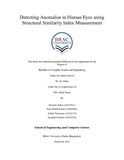| dc.contributor.advisor | Uddin, Dr. Jia | |
| dc.contributor.author | Jahan, Monwar | |
| dc.contributor.author | Rushu, Fazle Rabbi | |
| dc.contributor.author | Tabassum, Subah | |
| dc.contributor.author | Ferdous, Jannatul | |
| dc.date.accessioned | 2019-04-16T09:11:28Z | |
| dc.date.available | 2019-04-16T09:11:28Z | |
| dc.date.copyright | 2018 | |
| dc.date.issued | 2018-12 | |
| dc.identifier.other | ID 14101011 | |
| dc.identifier.other | ID 14101092 | |
| dc.identifier.other | ID 14101172 | |
| dc.identifier.other | ID 14101226 | |
| dc.identifier.uri | http://hdl.handle.net/10361/11722 | |
| dc.description | This thesis is submitted in partial fulfilment of the requirements for the degree of Bachelor of Science in Computer Science and Engineering, 2018. | en_US |
| dc.description | Cataloged from PDF version of thesis. | |
| dc.description | Includes bibliographical references (pages 20-21). | |
| dc.description.abstract | From the idea of anomaly, we come to learn that basically it is an idea of abnormality of eyesight, and interruption on the screen of eyes that does not fit with the rest of the pattern. Whatever we see or the images we look at are made up of lights reflected from the object we look at. Cornea, lens acquas humor, sclera, retina, choroid, optic nerve each of these components are equally important for eyesight. A slight defect in any part of these components will highly effect to our eyesight. Our main aim is to identify all the eyesight related problems through object detection using image processing. Our target result will be within a range of -1 to1 which will be the structural difference between healthy and unhealthy human eyes. We have identified the problems following two algorithms, one is SSIM and another is Eucledian Distance. In SSIM, we are comparing one healthy eye to another infected eye to distinguish the difference, by which we suggest the detected anomaly to the user. In Eucledian Distance, we are measuring the size of the IRIS to detect eye anomalies like myopia and lazy eye. From our results, we got the values between our expected ranges with slight error margining. | en_US |
| dc.description.statementofresponsibility | Monwar Jahan | |
| dc.description.statementofresponsibility | Fazle Rabbi Rushu | |
| dc.description.statementofresponsibility | Subah Tabassum | |
| dc.description.statementofresponsibility | Jannatul Ferdous | |
| dc.format.extent | 21 pages | |
| dc.language.iso | en | en_US |
| dc.publisher | Brac University | en_US |
| dc.rights | Brac University theses are protected by copyright. They may be viewed from this source for any purpose, but reproduction or distribution in any format is prohibited without written permission. | |
| dc.subject | Structural similarity | en_US |
| dc.subject | Anomaly detection | en_US |
| dc.subject.lcsh | Image processing--Digital techniques. | |
| dc.subject.lcsh | Imaging systems in medicine. | |
| dc.subject.lcsh | Diagnostic imaging--Digital techniques. | |
| dc.title | Detecting anomalies in human eyes using structural similarity index measurement | en_US |
| dc.type | Thesis | en_US |
| dc.contributor.department | Department of Computer Science and Engineering, Brac University | |
| dc.description.degree | B. Computer Science and Engineering | |

